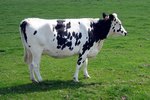Nephritis is the inflammation of one or both kidneys. Pyelonephritis in cows is infectious nephritis caused by a bacterial infection of the kidney. This infection is usually a result of an ascending infection from the lower urinary tract. Pyelonephritis, commonly referred to as kidney infection occurs frequently, yet is often misdiagnosed. It can present itself as the sole health issue or can be secondary to other simultaneously occurring infections. With careful observation and a few diagnostic tools, kidney-infection symptoms can be identified and successfully treated.
Acute Clinical Signs
Acute or sudden onset of an infection can cause a fever in cattle of 103.5 to 105.5° F. Some may suffer from a loss of appetite, go off feed and become anorexic. Milk production in lactating cows may decrease. Trouble passing urine, frequent and excessive urination or standing with their back arched are common signs of a kidney infection. Cattle kicking at their abdomen, pacing or being restless may be exhibiting signs of colic associated with the pain caused by both kidney infection and renal or ureteral inflammation. Post calving (after giving birth), any animal showing signs of colic should be considered a candidate for kidney infection
Chronic Clinical Signs
Cattle with chronic kidney infections may express their symptoms completely differently. Over a period of time, weight loss will occur leading to anorexia. The hair coat of an animal with an infection will be dull and rough. If lactating, milk production is poor with a chronically infected animal. Signs also include excessive passage of urine (polyuria) or diarrhea. Difficulty urinating, discolored or abnormal urine and stretching out or a swayback appearance are associated with infection. A low red blood cell count (anemia) can also be a result of kidney infection. Renal pain commonly associated with chronic infections may cause expression of symptoms
Subclinical Signs
Subclinical (undetected) or latent kidney infections are much harder to diagnose. Cattle with pre-existing medical conditions may also harbor a kidney infection. Because some of these problems have more obvious signs, the kidney infection may be present but not visible (latent). During the first few months of lactation, a cow may experience several disorders separately or at once, including metritis, inflammation of the uterus, and mastitis, inflammation of the udder. These conditions can mask the signs of kidney infection. External physical signs can be hard to see during an evaluation. Manipulation and examination of the reproductive tract of cattle through rectal palpation may be required to determine if there is kidney pain or inflammation.
Diagnosis
Evaluating clinical signs can be helpful, but usually need to be combined with other forms of diagnosis. For example, fever occurs with acute infections, but not always with chronic. Several methods can be used to obtain an accurate diagnosis. Rectal palpation can detect the enlargement of the left kidney in unilateral or bilateral infections. However, unless the right kidney is extremely enlarged with a chronic infection, palpation isn’t able to detect it. Vaginal palpation allows for detection of subtle ureteral enlargements rectal palpations do not reveal. Urinalysis is useful in identifying abnormal levels of white and red blood cell counts, proteins and bacteria, especially in cattle not showing clinical signs. In addition, a urine culture will determine the infectious organism and assist with choosing an appropriate antibiotic.
Treatment

Treatment for a cow with a kidney infection is based on the outcome of the urine culture if one is performed. Identifying the organism causing the infection as well as its antimicrobial susceptibility will dictate the antibiotic prescribed by the attending veterinarian. The antibiotic chosen should sustain high concentrations in the urine. The selected antibiotic should not have a nephrotoxic (poisonous or damaging) effect on the kidneys. Always use medications approved for use in cattle. In severe cases, surgery may be required to remove a grossly enlarged and infected kidney. This type of enlargement is usually detected by a rectum palpation. Quick detection and accurate and timely treatment should ensure a full recovery.


